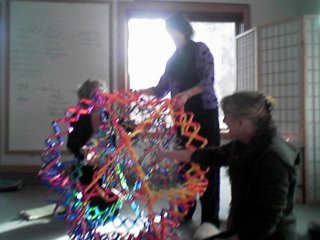studying

Question: What exactly are you studying?
Thanks for asking. I'm studying Biodynamic Craniosacral Therapy. I have a link to the homepage from here--see links to the right.
A young osteopathic student named William Garner Sutherland, at the turn of the twentieth century, began thinking that the skull bones were not fused but meant to sort of breathe. He tried bolting a football helmet to his head to prove that the bones of the skull don't move. It created strange personality changes, gastric disturbances, and disorientation and his wife made him stop. But he proved to himself that the cranial bones do move.
One of the things Sutherland did was for five years he just listened. One day he noticed a movement under his hands as the client's system adjusted itself. From this he gathered that there is an intelligence within the system. He called it the Breath of Life because he could palpate (to feel with one's hands) a very subtle rhythm or breathing.
If you've ever heard tapes of whales talking it reminds me of that. It's a very slow and long and fluid rhythmic breathing that is going on all the time all around us. It's not a sound per se but the whale song just reminds me of it.
When that "breathing" meets our tissues and bones it becomes a primary respiration. The sides of our skulls shows the tip of a bone that looks like a little gill. One day the thought struck Sutherland "beveled like the gills of a fish for primary respiration." This bizarre thought led him to his lifework. He was known as a very gentle and spiritual man.
So secondary respiration is our lungs breathing air. The primary respiration is when this very slow fluid-like breathing that is going on all the time in the universe meets our body. It goes through the tissue, bone and muscle--every cell. It's the underlying Health or Resource which is not affected by trauma or illness. When it gets blocked or sits in inertia there is pain and suffering. So craniosacral therapy is an approach to noticing and mirroring so the client can notice their own Health. When you focus on something it grows. So this work does not focus on pathology but on what is working well in the client.
In our society, most of us are not tuned into that and become sort of wrapped up very tightly. It's a state of sort of disassociated shock. Like how much do you notice your body sense? So it's a way that a lot of us (including myself) are walking around outside of our bodies in a certain way. And that would be fine except when we can tune into the subtle rhythm and settle a bit--it doesn't mean we walk around like zombies, you can actually move and speak quickly while in contact with the longtide--but it gives the system a chance to discharge stress, shock and so on and live in a space where there's resource and connection.
So it's the practitioner who is in touch with the longtide and just sits with the client and gently guides them. We don't try to force anything to happen, just invite it and the Intelligence of the client's own system presents the treatment plan according to how safe it is and whether there's resource enough.
It's very good stuff. I'm only beginning. So I am at the very beginning trying very small steps with contacting the longtide and noticing my own primary respiration. It's not easy. Yesterday Anna asked me, "Do you feel your shoulder rolling out?" I did. I was on the table and I had one student contacting my sacrum, an assistant supporting her and then Anna came and held my hand by my left shoulder. I began to settle and little twitches started to happen as my nervous system discharged stress or shock, then as we contacted the more fluid states of being I felt these little bubbles under my skin in wierd places like my arm and my knee. And I felt like I was spreading like pancake batter.
At first I had felt scared on the table and Anna helped my fellow student to "contact" me. Like there was a way she had been there but not really with me. It's amazing what a difference it makes just to shift inside yourself. Everyone in the room can feel it. So underneath the Breathing I'm telling you about is a Stillness.
When you inhale (air with your lungs) there's actually a little space of stillness, then the exhale and stillness again. It's the same way on deeper levels. And that Stillpoint (it's referred to) is also an amazing place to be in. The difference between the Stillpoint and just plain numbness or frozen terror is you can feel a dynamism there an aliveness, an expansion. In that place is very healing for the system and sometimes just sitting in the longtide can lead to the Stillpoint.
Anyway, I hope I haven't bored you. Don't worry if it doesn't make sense. It's one of those things that you kind of need another person with you who is experienced. If you're interested, look on the website link and there is a practitioner referral link so you can search and see if there are any practitioners in your area. Biodynamic Craniosacral is a little different than the mechanical craniosacral, such as Upledger. It has embraced the more mystical aspects of this work.
Has this explanation been helpful? Feel free to ask more questions if something wasn't clear. It's helping me review what I'm learning to write about it.


1 Comments:
At 7:45 AM, MaryAnn said…
MaryAnn said…
i appreciate this information. i went to my CST yesterday, and she spoke of the midtide and stillpoint. i wanted to learn more so googled midtide and found your blog! thanks.
Post a Comment
<< Home